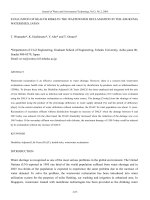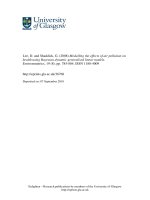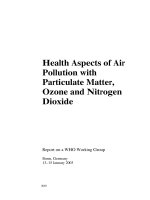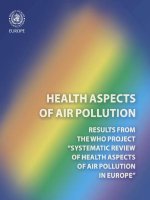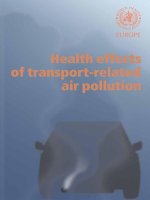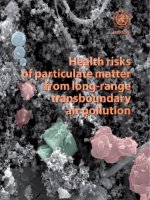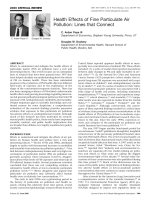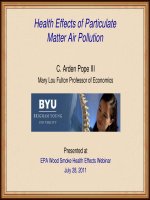Health risks of ozone from long-range transboundary air pollution pdf
Bạn đang xem bản rút gọn của tài liệu. Xem và tải ngay bản đầy đủ của tài liệu tại đây (1.83 MB, 111 trang )
World Health Organization
Regional Office for Europe
Scherfigsvej 8, DK-2100 Copenhagen Ø, Denmark
Tel.: +45 39 17 17 17. Fax: +45 39 17 18 18
E-mail:
Web site: www.euro.who.int
Ozone is a highly oxidative compound formed in the lower
atmosphere from gases (originating to a large extent from
anthropogenic sources) by photochemistry driven by solar
radiation. Owing to its highly reactive chemical properties, ozone
is harmful to vegetation, materials and human health. In the
troposphere, ozone is also an e cient greenhouse gas. This report
summarizes the results of a multidisciplinary analysis aiming to
assess the e ects of ozone on health. The analysis indicates that
ozone pollution a ects the health of most of the populations of
Europe, leading to a wide range of health problems. The e ects
include some 21 000 premature deaths annually in 25 European
Union countries on and after days with high ozone levels. Current
policies are insu cient to signi cantly reduce ozone levels in
Europe and their impact in the next decade.
HEALTH RISKS OF OZONE FROM LONG-RANGE TRANSBOUNDARY AIR POLLUTION
Health risks
of ozone
from long-range
transboundary
air pollution
© World Health Organization 2008
All rights reserved. The Regional Office for Europe of the World Health Organization welcomes requests for permission
to reproduce or translate its publications, in part or in full.
The designations employed and the presentation of the material in this publication do not imply the expression of any
opinion whatsoever on the part of the World Health Organization concerning the legal status of any country, territory,
city or area or of its authorities, or concerning the delimitation of its frontiers or boundaries. Dotted lines on maps repre-
sent approximate border lines for which there may not yet be full agreement.
The mention of specific companies or of certain manufacturers’ products does not imply that they are endorsed or recom-
mended by the World Health Organization in preference to others of a similar nature that are not mentioned. Errors and
omissions excepted, the names of proprietary products are distinguished by initial capital letters.
All reasonable precautions have been taken by the World Health Organization to verify the information contained in this
publication. However, the published material is being distributed without warranty of any kind, either express or implied.
The responsibility for the interpretation and use of the material lies with the reader. In no event shall the World Health
Organization be liable for damages arising from its use. The views expressed by authors, editors, or expert groups do not
necessarily represent the decisions or the stated policy of the World Health Organization.
Cover photos: ©Paul Hampton | Dreamstime.com − © Godfer | Dreamstime.com (children playing ball)
Edited by: Frank Theakston. Book design: Sven Lund
Address requests about publications of the WHO Regional Office for Europe to:
Publications
WHO Regional Office for Europe
Scherfigsvej 8
DK-2100 Copenhagen Ø, Denmark
Alternatively, complete an online request form for documentation, health information, or for permis-
sion to quote or translate, on the Regional Office web site ( />Keywords
AIR POLLUTANTS, ENVIRONMENTAL - adverse effects
OZONE
RISK ASSESSMENT
ENVIRONMENTAL EXPOSURE
ENVIRONMENTAL MONITORING
ISBN 978 92 890 42895
Abstract
Ozone is a highly oxidative compound formed in the lower atmosphere from
gases (originating to a large extent from anthropogenic sources) by photochem-
istry driven by solar radiation. Owing to its highly reactive chemical properties,
ozone is harmful to vegetation, materials and human health. In the troposphere,
ozone is also an efficient greenhouse gas. This report summarizes the results of
a multidisciplinary analysis aiming to assess the effects of ozone on health. The
analysis indicates that ozone pollution affects the health of most of the popula-
tions of Europe, leading to a wide range of health problems. The effects include
some 21 000 premature deaths annually in 25 European Union countries on and
after days with high ozone levels. Current policies are insufficient to significantly
reduce ozone levels in Europe and their impact in the next decade.
Markus Amann, Dick Derwent,
Bertil Forsberg, Otto Hänninen, Fintan Hurley,
Michal Krzyzanowski, Frank de Leeuw,
Sally J. Liu, Corinne Mandin, Jürgen Schneider,
Per Schwarze, David Simpson
Health risks
of ozone
from long-range
transboundary
air pollution
Acknowledgements
This report was prepared by the Joint WHO/Convention Task Force on the
Health Aspects of Air Pollution according to Memoranda of Understanding be-
tween the United Nations Economic Commission for Europe (UNECE) and the
WHO Regional Office for Europe (ECE/ENHS/EOA/2004/001 and ECE/ENHS/
EOA/2008/001). WHO thanks the Swiss Federal Office for the Environment for
its financial support of the work of the Task Force. Additional contributions from
Anne-Gunn Hjellbrekke of the Norwegian Institute for Air research (NILU) are
gratefully acknowledged.
Convention on Long-range Transboundary Air Pollution
Abbreviations vii
Executive summary ix
1. Introduction 1
Structure of the report 2
2. Hazard assessment of ozone 3
Ozone toxicokinetics 3
Acute responses 5
Chronic effects in humans 11
Thresholds 15
Susceptible groups 17
Health implications 18
3. Sources of ozone precursors 21
Ozone formation and atmospheric transport 21
Sources of ozone precursor emissions 23
Projections of future emissions of ozone precursors 24
Interactions of ozone precursor emissions with other 30
environmental problems
4. Ozone levels 31
Monitoring results 31
Observed ozone trends 39
Modelling techniques and validation 47
Ozone and climate change 50
Contents
5. Population exposure projections 53
Exposure versus ambient measurements 54
Population exposure modelling 56
6. Risk estimates 59
Effects of ozone on mortality 60
Estimation of impacts on morbidity 65
Health effects and cost–benefit analysis 71
Transferability between populations 72
Evidence on reversibility of the health impacts 73
7. Conclusions 75
Ozone air pollution is a significant health hazard in Europe 75
Health effects of long-range transboundary ozone are most likely 75
proportional to the contribution of long-range sources to ozone
exposure levels
Current policies lead to only a small reduction in risk 76
Key uncertainties, research needs and policy implications 76
References 79
Annex 1. List of Working Group members and reviewers 95
Organizations and programmes
ACS American Cancer Society
AHSMOG Adventist Health and Smog (study)
AirBase European air quality database (net.
europa.eu/databases/airbase/)
CAFE Clean Air for Europe Programme of the European
Commission ( />l28026.htm)
CAFE CBA CAFE Cost–Benefit Analysis project
()COMEAP Committee on the
Medical Effects of Air Pollution
COMEAP Committee on the Medical Effects of Air Pollution
ECHRS European Community Respiratory Health Survey
EEA European Environment Agency (www.eea.europa.eu)
EMEP Cooperative Programme for Monitoring and Evaluation of
the Long-range Transmission of Air Pollutants in Europe
(www.emep.int)
EU European Union
EU15 European Union with 15 Member States as it existed
between 1995 and 2004
EU25 European Union with 25 Member States as it existed
between 2004 and 2007
GAINS Greenhouse gas – Air pollution INteractions and Synergies
IPCC Intergovernmental Panel on Climate Change
ISAAC International Study of Asthma and Allergies in Childhood
MSC-W EMEP Meteorological Synthesizing Centre – West, hosted
by the Norwegian Meteorological Institute
RAINS Regional Air Pollution Information and Simulation model
of IIASA
Abbreviations
viiABBREVIATIONS
HEALTH RISKS OF OZONE FROM LONG-RANGE TRANSBOUNDARY AIR POLLUTIONviii
UNECE United Nations Economic Commission for Europe
(www.unece.org)
IIASA International Institute for Applied Systems Analysis, Vienna
( />OECD Organisation for Economic Co-operation and Development
Technical terms
AOT40/AOT60 accumulated ozone above the level of 40/60 ppb, a measure
of cumulative annual ozone concentrations used as
indicator of vegetation (health) hazards
CI confidence interval (a measure of statistical uncertainty
in numerical estimates)
CIMT carotil intima-media thickness
CLE current legislation (concerning emission of pollutants
to the atmosphere)
COPD chronic obstructive pulmonary disease
DALY disability-adjusted life-year (a measure of health burden)
ELF epithelial lining fluid
FEF
25–75
forced expiratory flow between 25% and 75% FVC
FEF
75
forced expiratory flow at 75% FVC
FEV
1
forced expiratory volume in 1 second (measure
of respiratory function)
F gases fluorinated greenhouse gases (hydrofluorocarbons,
perfluorocarbons and sulfur hexafluoride)
FVC forced vital capacity (measure of respiratory function)
HIS United States Health Interview Study
HRV heart rate variability
ix
ABBREVIATIONS
ICD-9 International Statistical Classification of Diseases and
Related Health Problems, ninth revision
LRS lower respiratory symptoms
LRTAP long-range transboundary air pollution
MTFR maximum technologically feasible reduction
(concerning emission of pollutants to the atmosphere)
NO
x
nitrogen oxides
NOy reactive nitrogen oxide
OH hydroxyl radical
OFIS ozone fine structure model
PAN peroxyacetyl nitrate
PM particulate matter
ppb/ppm parts per billion/parts per million (volumetric unit
of concentration)
PPP$ purchasing power parity dollars
RADs restricted activity days
RHAs respiratory hospital admissions
SOMO35 sum of maximum 8-hour ozone levels over 35 ppb
(70 µg/m
3
) (a measure of accumulated annual ozone
concentrations used as an indicator of health hazards
(overall long-term ozone levels); see Box 4.2 (page 36)
for a more complete definition)
SOMO0 sum of maximum 8-hour ozone levels without a threshold
VOC volatile organic compound
xiEXECUTIVE SUMMARY
Executive summary
This report summarizes the results of a multidisciplinary analysis aiming to as-
sess the health effects of ozone, and especially the part that is contributed by re-
mote sources. The analysis indicates that ozone pollution affects the health of
most of the populations of Europe, leading to a wide range of health problems.
Currently implemented policies are not sufficient to reduce impacts significantly
in the next decade.
Ozone is a highly oxidative compound formed in the lower atmosphere from
gases (originating to a large extent from anthropogenic sources) by photochem-
istry driven by solar radiation. Owing to its highly reactive chemical properties,
ozone is harmful to vegetation, materials and human health. In the troposphere,
ozone is also an efficient greenhouse gas.
Health hazard
As to short-term exposures, recent epidemiological studies have strengthened the
evidence that daily exposures to ozone increase mortality and respiratory mor-
bidity rates. These studies have provided information on concentration–response
relationships and effect modification. In short-term studies on pulmonary func-
tion, lung inflammation, lung permeability, respiratory symptoms, increased
medication usage, morbidity and mortality, ozone appears to have effects inde-
pendent of other air pollutants such as particulate matter (PM). This notion that
ozone may act independently is strengthened by controlled human studies and
experimental animal studies showing the potential of ozone per se to cause ad-
verse health effects, especially in vulnerable people. Controlled human studies
on PM and ozone combined corroborate this view.
As to long-term exposures, new epidemiological evidence and experimental
animal studies on inflammatory responses, lung damage and persistent struc-
tural airway and lung tissue changes early in life also indicate effects of long-term
exposure to ozone. This evidence is still too limited for firm conclusions to be
drawn, however, but in the future it may be possible to identify health effects
from long-term exposure to ozone.
Sources and emission trends
The most important pollutants that play a role in the formation of tropospheric
ozone include nitrogen oxides (NO
x
) and volatile organic compounds (VOCs) as
well as, to a lesser but still significant extent, methane and carbon monoxide. The
pace of photochemical reactions forming ozone in the atmosphere depends on
HEALTH RISKS OF OZONE FROM LONG-RANGE TRANSBOUNDARY AIR POLLUTIONxii
solar radiation and temperature. Inside and close to urban areas, ozone concen-
trations may be depressed because of reactions with NO
x
but further downwind
(in rural areas) both NO
x
and VOCs tend to promote ozone formation.
Emissions of NO
x
occur in the most densely populated areas, particularly in
northwestern Europe. On the other hand, VOC emissions are more evenly dis-
tributed in Europe, the main anthropogenic sources being traffic and solvent use.
In European Union (EU) countries, emissions of ozone precursors are expected
to decline further, even assuming accelerated economic growth, dropping by 2020
to half the 2000 levels. For these pollutants, contributions from the traditionally
dominant source sectors (energy production, industry and road transport) will
significantly decrease. In the future, the relative roles of other sectors that cur-
rently have less strict legislation (including shipping, diesel-powered heavy-duty
and off-road vehicles for NO
x
and solvent use for VOC) will increase. However,
the lack of relevant, stringent legislation in many non-EU countries may result in
further increases in ozone precursor emissions in these parts of the region cov-
ered by the Convention on Long-range Transboundary Air Pollution.
Ozone levels and trends
Even though emissions of ozone precursors have fallen over large parts of Eu-
rope since the late 1980s, ozone levels continue to cause health concerns, with the
highest levels in south and central Europe. Concentrations in southern Europe
are higher than in northern Europe and are higher in rural than in urban areas.
Peak ozone values fell in several regions in Europe during the 1990s, while there
was no trend in the sum of maximum 8-hour ozone levels over 35 ppb (70 µg/m
3
)
(SOMO35), a metric used for ozone health impact assessment. Ozone levels are
strongly influenced by annual variations in weather conditions and trends in the
hemispheric background concentrations.
Simulations of SOMO35 for 2010 indicate that emissions overall will be
slightly lower than in 2000 in central Europe. However, in some (urban) areas,
the combination of reduced NO
x
titration and an increasing contribution of
hemispheric background ozone is leading to increasing ozone levels in cities and
increased population exposures to ground-level ozone. Regional differences in
ozone levels across Europe are expected to decrease in the next decade. Expo-
sures in continental Europe are projected to go down by 20–30% in northern
Italy, Germany, southern France and Switzerland, and to rise in Scandinavia and
the British Isles.
Human exposure to ozone during the winter is reduced because more time
is spent indoors. Building structures and slow rates of ventilation reduce ozone
penetration indoors even during the summer.
xiiiEXECUTIVE SUMMARY
Health impact estimates
It is estimated that some 21 000 premature deaths per year are associated with
ozone exceeding 70 µg/m
3
measured as a maximum daily 8-hour average in 25
EU countries (EU25). The slight decline in ground-level ozone expected to re-
sult from current legislation, and taking account of current policies addressing
climate change (the CLE scenario), is estimated to reduce premature mortality by
only some 600 cases per year between 2000 and 2020. Markedly larger (around
40%) reductions could be achieved by implementing the maximum technically
feasible reduction (MTFR) scenario.
Ozone is also associated with 14 000 respiratory hospital admissions annu-
ally in EU25. It affects the daily health of large populations in terms of minor
restricted activity days, respiratory medication use (especially in children), and
cough and lower respiratory symptoms. The estimated figures are between 8 mil-
lion and 108 million person-days annually, depending on the morbidity out-
come. Expected reductions in morbidity outcomes related to the implementation
of current policies (CLE scenario) are more significant than those for mortal-
ity, ranging from approximately 8% (respiratory medication use of adults) to
40% (cough and lower respiratory symptoms in children). Nevertheless, hos-
pital admissions associated with ozone exposure are expected to increase ow-
ing to changes in population structure and larger populations of older people
at risk. The current health impact estimates consider only acute health effects,
and do not account for possible effects at short-term ozone exposure levels below
70 µg/m
3
or possible effects from long-term exposures.
While the premature mortality associated with ozone in EU25 is substantially
lower than that associated with fine PM, ozone is nevertheless one of the most
important air pollutants associated with health in Europe.
1INTRODUCTION
In most countries of the United Nations Economic Commision for Europe
(UNECE) region, ambient air quality has improved considerably in the last few
decades. This improvement was achieved by a suite of measures to reduce harm-
ful air emissions, including those stipulated by the various protocols under the
Convention on Long-range Transboundary Air Pollution (LRTAP). On the other
hand, there is convincing evidence that current levels of air pollution still pose a
considerable risk to the environment and human health.
The Convention on LRTAP has been extended by eight protocols. The Proto-
col to Abate Acidification, Eutrophication and Ground-level Ozone was adopted
by the Executive Body for the Convention in Gothenburg, Sweden in November
1999, has been signed by 23 Parties, and entered into force on 17 May 2005. While
early agreements on LRTAP were driven by concerns about the transboundary
transport of acidifying pollutants, effects on human health have attracted more
and more attention in recent years. These concerns led to the creation of the Joint
WHO/Convention Task Force on the Health Aspects of Air Pollution. The main
objective of this Task Force, which is chaired by WHO, is to prepare state-of-the-
art reports on the direct and indirect effects of air pollutants on human health.
WHO was already collaborating with the Convention on assessing the health
effects of ozone before the Task Force was created. A joint workshop was or-
ganized by the Convention, the WHO European Centre for Environment and
Health and the MRC Institute for Environment and Health and was hosted by
the United Kingdom Department of the Environment in Eastbourne on 10–12
June 1996. The workshop formulated recommendations related to the informa-
tion and methods needed to improve assessments of the health impacts of ozone
in Europe (1).
This report provides a concise summary of current knowledge on the risks to
health of ozone from LRTAP. It is targeted at various groups supporting imple-
mentation of the Convention, including the Working Group on Strategies and
Review and the Executive Body. The report is also directed at decision-makers
at national level concerned with pollution abatement policies, as well as to scien-
tists who can contribute further information on all stages of assessing the risks to
health posed by ozone.
The main aim of this report is to provide a scientific rationale for estimating
the magnitude, spatial distribution and trends in the health burden caused by
exposure to ozone in ambient air in Europe, and in particular the contribution
to ozone levels from the long-range transport of pollutants. It combines the evi-
1. Introduction
2 HEALTH RISKS OF OZONE FROM LONG-RANGE TRANSBOUNDARY AIR POLLUTION
dence generated in the recent update of WHO’s air quality guidelines (2) and in
the work on modelling and assessment of ozone levels conducted for the Con-
vention as well as for the European Commission’s Clean Air for Europe (CAFE)
programme.
This report focuses on tropospheric ozone, which, owing to its highly oxida-
tive properties, is harmful to human health, vegetation and materials. In the up-
per layer of the atmosphere, the stratosphere, ozone is formed from oxygen in
reactions initiated by solar radiation. Approximately 90% of atmospheric ozone
is formed in the stratosphere, where it plays a highly valuable role in absorbing
ultraviolet light, an excess of which is harmful to life on Earth.
The long-range contribution to ozone levels is equivalent to the regional back-
ground of ozone, which includes naturally occurring ozone. This contribution is
not strongly influenced by single emission sources and should be roughly equiv-
alent to (a) those measured at rural (background) locations and (b) air pollution
levels estimated by regional air transport models.
Structure of the report
Following a concise summary on hazard identification given in Chapter 2, largely
based on the results of the recent update of WHO’s air quality guidelines (2),
Chapter 3 provides an overview of the sources of ozone precursors (pressure). The
emission data are derived both from national submissions to the UNECE secre-
tariat and from expert estimates. Atmospheric distribution and transformations,
as well as current ambient levels and trends of tropospheric ozone (state), are
described in Chapter 4. A section on ozone levels from ambient air monitoring
is complemented by a description of estimates from the Unified Eulerian EMEP
model. These data are a prerequisite for Chapter 5 on exposure assessment.
The overall assessment of the health effects is completed in Chapter 6 using a
risk assessment approach, integrating the information on exposure, concentra-
tion–response and background frequency of the considered effect. Most of the
calculations were made in support of the CAFE programme, following the meth-
odology agreed by the Joint WHO/Convention Task Force in 2004.
The first draft of this report was prepared in 2005. Its consecutive drafts were
discussed by the Task Force at meetings in 2006 and 2007, providing input to the
discussions of the Working Group on Effects. The revised and updated draft was
on the agenda of the 11th meeting of the Task Force, held in Bonn on 17–18 April
2008, which formulated the “key messages” of each chapter, executive summary
and conclusions of the assessment presented in Chapter 7. The executive sum-
mary was used as a contribution to the report of the Task Force presented to the
27th session of the Working Group on Effects (3).
3HAZARD ASSESSMENT OF OZONE
Evaluation of the accumulated evidence on the hazards of exposure to ozone was
recently completed by WHO in the 2005 update of its air quality guidelines (2).
This chapter is based, to a large extent, on the results of this evaluation.
Ozone toxicokinetics
Because of its high reactivity and low solubility in water, exposure to ozone via
liquid or solid media is negligible and ozone uptake is thus almost exclusively
by inhalation. As to other routes of exposure, there is evidence of effects in the
tear duct epithelial cells of individuals exposed to ambient ozone levels (4) and
in the skin of laboratory animals exposed to extremely high concentrations (5).
Nevertheless, it is likely that ozone effects on skin are restricted to the upper lay-
ers of the dermis and that no absorption occurs in its innermost compartments.
Thiele et al. (6) demonstrated that short-term exposure of mice to high levels
of ozone significantly depleted vitamins C and E and induced malondialdehyde
formation in the upper epidermis but not in underlying layers. There is currently
no evidence that oxidative stress by ambient ozone levels would interfere with
epidermal integrity and barrier function and predispose to skin diseases.
Most absorption of ambient ozone occurs in the upper respiratory tract and
conducting intrathoracic airways (7,8). Total ozone uptake is at least 75% in adult
males (9). The rate of absorption may change, being inversely proportional to
flow rate and increasing as tidal volume increases (8). As tidal volume increases,
there is a shift from nasal to oral breathing, with most of the inhaled air entering
2. Hazard assessment of ozone
•
• Ozone is a highly reactive gas that triggers oxidative stress when it enters the
airways.
•
• Adverse structural, functional and biochemical alterations in the respiratory
tract occur at current ozone levels, as confirmed by animal and autopsy data.
•
• Exposure to ozone increases daily mortality and morbidity levels in
populations.
•
• The risk of effects increases in proportion to the ozone level, with a significant
increase in mortality observed above 50–70 µg/m
3
(measured as a 1- or 8- hour
average).
•
• Evidence of chronic effects is currently less conclusive. New evidence of such
effects is emerging, such as that on small airway function and possibly on
asthma development; if these are confirmed, the health concerns will increase.
KEY MESSAGES
HEALTH RISKS OF OZONE FROM LONG-RANGE TRANSBOUNDARY AIR POLLUTION4
through the mouth at flow rates exceeding 40 litres per minute (10). Since ozone
removal in the upper respiratory tract is lower for oral than for nasal inhalation,
ozone penetration into the lungs is much higher in people engaged in vigorous
physical activity. Age and gender also influence ozone absorption, in both quan-
tity and topography, because of variations in airway size and the tissue surface
of the conducting airways, leading to higher levels of absorption in children and
women (7).
Diffusion of ozone across the airway epithelial lining fluid (ELF) (Fig. 2.1) is
determined by its reactivity, and direct contact of ozone with airway epithelium
seems to be small (11). ELF contains substrates such as ascorbic acid, uric acid,
glutathione, proteins and unsaturated lipids that may undergo oxidation medi-
ated by ozone (12), thus preventing (or minimizing) damage to the underlying
epithelium. ELF is constantly renewed by the mechanical input provided by the
coordinated movement of airway ciliated cells, producing new biological sub-
strates to react with ozone and thus acting as a chemical barrier against this pol-
lutant. However, oxidation of some components of ELF may generate bioactive
compounds, such as lipid hydroperoxides, cholesterol ozonization products,
Ozone
Alveolus
Terminal airways
Alveolus
Lining
fluid
Macrophage
Macrophage
Lymphocyte
Carbohydrates
Cilia
CC16
Surfactant
Lipids
Proteins
Antioxidants
Secondary
oxidants
B
A
C
D
E
F
G
H
A type I pneumocyte (air–blood gas exchange)
B type II pneumocyte (produces surfactant and regenerates
lining)
C Clara cell (secretes CC16)
D ciliated airway cell (brings particles up to the throat/nose)
E goblet cell producing mucus
F basal regenerative cell
G bronchial gland producing proteins and a little mucus
H blood vessel (gas exchange in air sacs, cell migration into lining
fluid and surrounding tissues)
Fig. 2.1. Interactions of ozone with the terminal airway lining fluid and cells
5HAZARD ASSESSMENT OF OZONE
ozonides and aldehydes, with the potential to elicit inflammation and cell dam-
age (13).
Modelling studies show that the total percentage ozone taken up by the lungs
is not markedly affected by age, but this changes when the amount of ozone ab-
sorbed is normalized by the regional surface area of the different segments of the
respiratory tract (8). Malnutrition may interfere with the availability of antioxi-
dant substances in ELF, such as vitamin E. Pre-existing pulmonary disease, such
as chronic bronchitis, asthma or emphysema, leads to mechanical unevenness
of airflow because of regional differences in the time constants of parallel respi-
ratory units, thus interfering with the tissue dosimetry of ozone. Thus, for any
given ambient level of ozone concentration, its toxicity, preferential site of dam-
age and pathogenetic mechanisms may vary depending on various factors in the
human receptor.
Studies on rodents and non-human primates to relatively high levels of ozone
have shown structural changes in the peripheral parts of the lung. The structural
changes in the primates were found after six months of exposure to 0.5 ppm
ozone. The age at which the monkeys were exposed corresponds approximately
to early childhood in humans: the first 2–3 years of life. After discontinuation of
exposure the animals were followed for another six months (equivalent to about
1½ years for humans) but the changes persisted. Though not directly relatable to
a disease, persisting structural changes should be regarded as an adverse effect
(14,15).
Acute responses
For acute responses (other than the newly emerging area of cardiovascular func-
tion), there is a very large and rapidly growing literature that was summarized as
part of the WHO air quality guidelines development process (3). Judgement is
required in the interpretation of pulmonary system effects, in that some of the
measurable effects may not be worthy to be considered adverse. By contrast, any
excess hospital admissions and excess daily mortality attributable to ozone is
clearly adverse.
Epidemiological studies used daily ozone levels (measured as maximum daily
1- or 8-hour average) as the exposure indicator. Recently published meta-anal-
yses use the daily average to ensure the comparability of the results of various
studies. All three indices are highly correlated. The widely used conversion of
1-hour maximum, 8-hour maximum and daily average is 20:15:8 (16). The WHO
air quality guidelines (2) refer to the 8-hour average, as being more closely related
to the average daily exposure and inhaled dose.
Pulmonary system effects
Very many experimental studies have been performed on the acute effects of
ozone exposure in humans. They have employed various approaches: controlled
HEALTH RISKS OF OZONE FROM LONG-RANGE TRANSBOUNDARY AIR POLLUTION6
exposures at rest or during exercise; single or continuous exposures; exposures at
ambient levels; and evaluating the effects of ozone on subjects with pre-existing
pulmonary disease such as asthma or chronic bronchitis. The studies listed in the
WHO air quality guidelines (Annex 1, Table 1) (2), on the acute effects of ozone
exposure on physiological parameters in humans, support the following conclu-
sions.
•
There is solid evidence that short-term exposure to ozone impairs pulmonary
function.
•
Controlled exposures indicate that transient obstructive pulmonary altera-
tions may occur for 6.6-hour exposures at an ozone level of 160 µg/m
3
, a con-
centration frequently surpassed in many locations in the world.
•
People with asthma and allergic rhinitis are somewhat more susceptible to
transient alterations in respiratory function caused by acute exposure to
ozone.
•
Changes in pulmonary function and depletion of airway antioxidant defences
are immediate consequences of ozone exposure. Increase in inflammatory
mediators, upregulation of adhesion molecules and inflammatory cell recruit-
ment can be detected hours after exposure and may persist for days.
•
Ozone enhances airway responsiveness in both healthy individuals and asth-
matics.
•
Studies conducted under field conditions, such as summer camps, have de-
tected transient functional effects at ozone levels considerably lower than
those observed in controlled exposures. Various factors may account for this
discrepancy: concomitant exposure to other pollutants (including other com-
ponents of the photochemical smog) and difficulties in precisely determining
individual exposure (present and past). On the other hand, one has to consider
that the lower threshold for adverse effects may be influenced by the higher
number of days of observation in such studies, thus increasing the power of
detecting a significant effect.
The vast majority of the epidemiological studies considered in the 2005 global
update of the guidelines (2) obtained positive and significant associations between
variations in ambient ozone levels and increased morbidity. School absenteeism,
hospital admissions or emergency department visits for asthma, respiratory tract
infections and exacerbation of existing airway disease were the most common
health end-points. The effects were manifested among children, elderly peo-
ple, asthmatics and those with chronic obstructive pulmonary disease (COPD).
The magnitude of the risk for respiratory morbidity associated to an increase of
20 µg/m
3
ozone ranged from zero to 5%. The estimated magnitude of the increase
in risk found by various studies is presented in more detail in Chapter 6.
Exposure to ozone has been shown to increase the likelihood of wheeze and
chest tightness, increase the risk of morning symptoms of asthma, and reduce
Meta-analysis/
outcome/disease
Age group
(years)
Relative risk
(95% CI)
Number of studies
analysed
Bell et al. (16)
a
All-cause mortality, all seasons All ages 1.004 (1.003–1.009) 32
All-cause mortality, summer All ages 1.007 (1.004–1.011) 10
Cardiovascular mortality, all seasons All ages 1.005 (1.003–1.008) 18
Cardiovascular mortality, summer All ages 1.012 (1.004–1.020) 4
Ito et al. (31)
b
All-cause mortality All ages 1.002 (1.001–1.003) 43
Levy et al. (32)
b
All-cause mortality All ages 1.002 (1.002–1.003) 46
WHO (33)
c
All-cause mortality All ages 1.003 (1.001–1.004) 15
Respiratory mortality All ages 1.000 (0.996–1.005) 12
Cardiovascular mortality All ages 1.004 (1.003–1.005) 13
Respiratory hospital admissions 0–14 Not observed 3
15–64 1.001 (0.991–1.012) 5
≥65 1.005 (0.998–1.012) 5
a
Daily.
b
Maximum 1-hour.
c
Maximum 8-hour.
Table 2.1. Relative risk estimates and confidence intervals for a 10-g/m increase in
daily, maximum 1-hour or maximum 8-hour average ozone for all-cause and cause-
specific mortality and respiratory hospital admissions in recent meta-analyses
7HAZARD ASSESSMENT OF OZONE
morning peak expiratory flow rates (17,18) in children with lower birth weights
or those born prematurely.
There are large multi-city studies relating the numbers of hospital admissions
for respiratory diseases (19) and COPD (20) to ambient ozone levels. Such as-
sociations were robust enough to persist after controlling for temporal trends in
admission rates, day-of-the-week and seasonal effects, gaseous and particulate
air pollution, and climatic factors. Effects of ozone on respiratory admissions
seem stronger during warmer weather. A meta-analysis by WHO of the Euro-
pean studies (21) provided summary risk estimates for respiratory admissions
in the age ranges 15–64 and ≥65 years of 1.001 and 1.005 per 10 g/m
3
ozone,
respectively. However, the variability of the results was large and the lower limit
of 95% confidence interval (CI) was below 1 (Table 2.1). Three estimates were
available for respiratory admissions in children aged 0–14 years; a meta-analysis
of these estimates gave a summary relative risk of 0.999 (21).
Cardiovascular system effects
The effect of ambient air pollution on cardiovascular function and the initia-
tion and progression of cardiovascular disease in laboratory animals and human
HEALTH RISKS OF OZONE FROM LONG-RANGE TRANSBOUNDARY AIR POLLUTION8
populations is an emerging field of interest and one of intense study. In studies
of acute responses in humans, however, there are difficulties in separating the ef-
fects due to peaks in particulate matter (PM) concentrations from those that may
be due to ozone.
Park et al. (22) conducted a study on 603 men in the Boston, Massachusetts
area who were enrolled in the Veterans Administration Normative Aging Study
and were undergoing routine electrocardiographic monitoring, including meas-
urement of heart rate variability (HRV). Reduced HRV is a well-documented
risk factor for cardiac disease. Low-frequency HRV was reduced by 11.5% (95%
CI 0.4–21.3) per 2.6-µg/m
3
increment in the previous 4-hour average of ozone,
and the effect was stronger in men with ischemic heart disease and hypertension.
There were also significant associations of HRV with PM
10
levels.
Rich et al. (23) studied patients with implanted defibrillators in the Boston
area, and reported an increased risk of paroxysmal atrial fibrillation episodes
associated with short-term increases in ambient ozone. The odds ratio for a
44-µg/m
3
increase in ozone during the hour before the arrhythmia was 2.1
(95% CI 1.2–3.5; P = 0.001). The associations with PM
2.5
, nitrogen dioxide and
black carbon were not significant.
These first studies of acute changes in cardiac function associated with expo-
sure to ambient ozone provide biological plausibility for the associations between
cardiac morbidity and mortality and ozone levels in the epidemiological studies.
Nevertheless, in 13 out of 19 studies focusing on hospital admissions for cardio-
vascular diseases, no significant effects of ozone were observed. Some of these
studies were reviewed in the update of the air quality guidelines (2). The more re-
cent studies from France (24), New Zealand (25) and the United States (Boston)
(26) all conclude that ozone was not associated with cardiovascular morbidity.
Several of the negative studies did not, however, include an adjustment for the
negative correlation between primary pollutants emitted during combustion and
ozone, thus limiting their ability to detect a positive association.
Mortality
The results of some representative studies relating ozone to mortality are sum-
marized in the WHO air quality guidelines (Annex 1, Table 3) (2). Significant as-
sociations were obtained for different causes, mainly respiratory and (to a lesser
extent) cardiovascular. The effects of ozone on mortality were detected mostly
in the elderly, and the studies focusing on mortality in children are not fully co-
herent. Interestingly, in Asia, ozone was associated with mortality due to stroke
(27). The magnitude of the mortality risk exhibited a seasonal variation, being
more intense in warmer weather. The range of the relative risk of mortality due
to respiratory diseases for an increase of 20 µg/m
3
ozone was between 1.0023%
(28) and 1.066% (29), such variation depending on age group, season and model
specifications. It is reasonable to postulate that adjusting the models for tempera-
9HAZARD ASSESSMENT OF OZONE
ture plays a significant role in the magnitude of the coefficients relating ozone
to mortality. The relationship between acute effects of ozone and mortality was
reinforced by the recent publication of four meta-analyses (16,30–32). These
were consistent in showing a significant association between ozone and short-
term mortality that was not substantially altered by exposure to other pollutants
(including PM), temperature, weather, season or modelling strategy. Increases
in total mortality have been observed at concentrations as low as 50–60 µg/m
3
(1-hour average) (30).
The meta-analysis of European studies published between 1996 and 2001 on
short-term effects of ozone on all non-accidental causes of death at all ages (or
older than 65 years) resulted in relative risks per 10-µg/m
3
increase in ozone of
1.003 for all-cause, 1.004 for cardiovascular and 1.000 for respiratory mortality
(CIs shown in Table 2.1) (21). In each group, the estimates are based on studies in
France, Italy, the Netherlands, Spain and the United Kingdom. More recent meta-
analyses, based on larger sets of studies, collectively demonstrate short-term as-
sociations between ozone and mortality, although the estimates of relative risk
vary between cities (16,31,32). The excess risk estimates were higher in summer
(when ozone levels are high and people spend more time outdoors) and lower or
null in cold seasons (when ozone levels are low and exposures are expected to be
low).
In the time-series studies, especially more recent ones, the ozone effect is usu-
ally adjusted for both temperature and season. Thus the stronger effects of ozone
reported for the summer season may largely be explained by negative correlation
between ozone and locally emitted combustion products (as traffic exhaust) in
winter. In the APHEA2 study, the effect of ozone in winter was as strong as that
in summer, if carbon monoxide was adjusted for (30).
A recent analysis of the effects of ozone on mortality in 48 cities in the United
States studied a hypothesis that deaths associated with exposure move the time
of death by only a short time (mortality displacement) (34). Analysing the lag
structure of mortality in a time-series model, the authors demonstrated that the
effect of exposure was larger (0.5% per 10 ppb ozone, 8-hour average) for deaths
occurring on days 0–3 after exposure than on the day of exposure alone (0.3%).
Further, there was no effect on mortality in the following period. This study dem-
onstrates that risk assessments using a single day of ozone exposure are likely to
underestimate, rather than overestimate, the public health impact.
Heatwaves and ozone
During August 2003, high temperatures were observed in western Europe.
France was the country most affected, with around 15 000 excess deaths. Ques-
tions then arose about the contribution of elevated ozone concentrations to the
health impact during the heatwave. In the follow-up period, several studies were
conducted to investigate the relationships between temperature, photochemical
